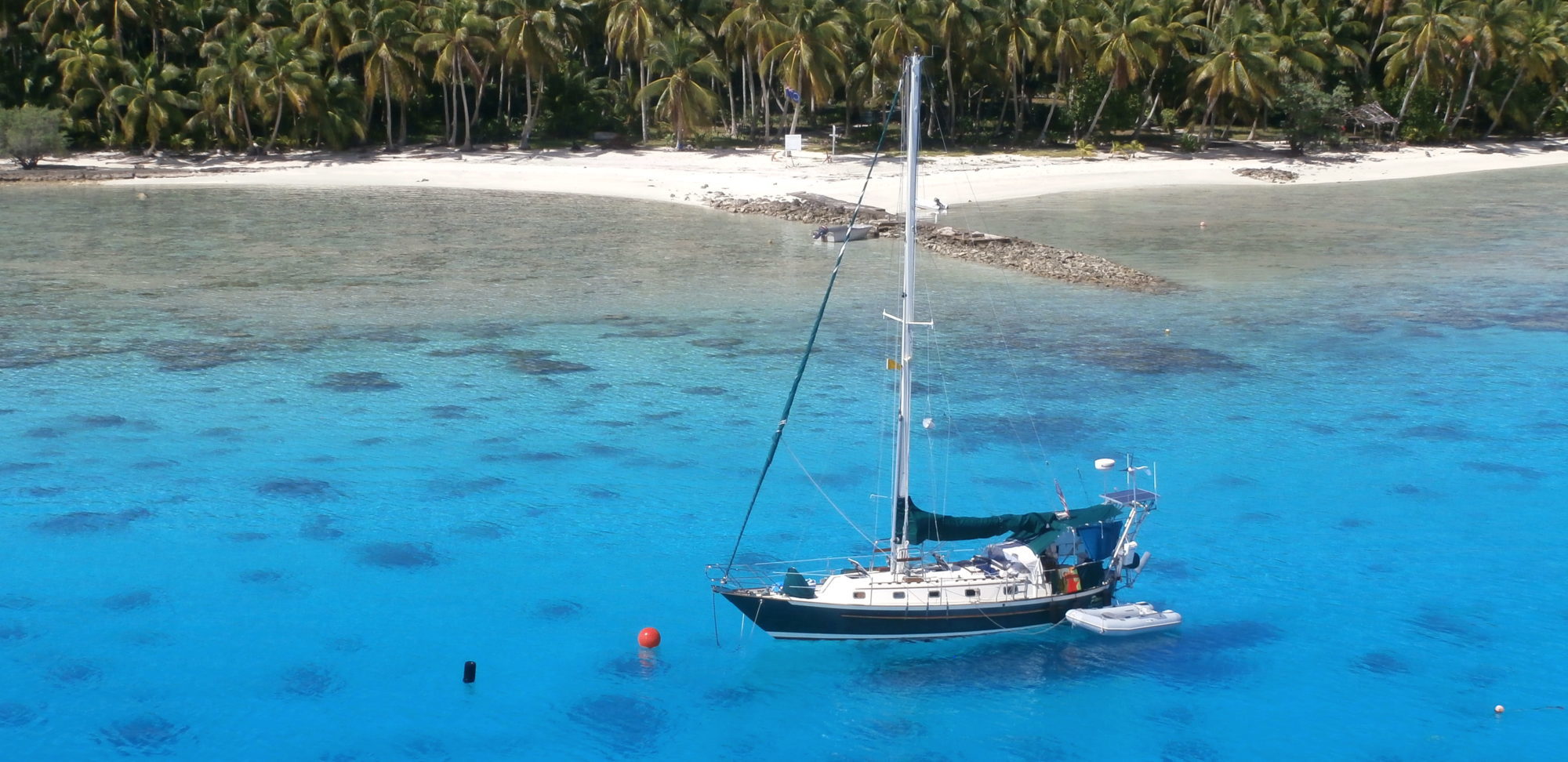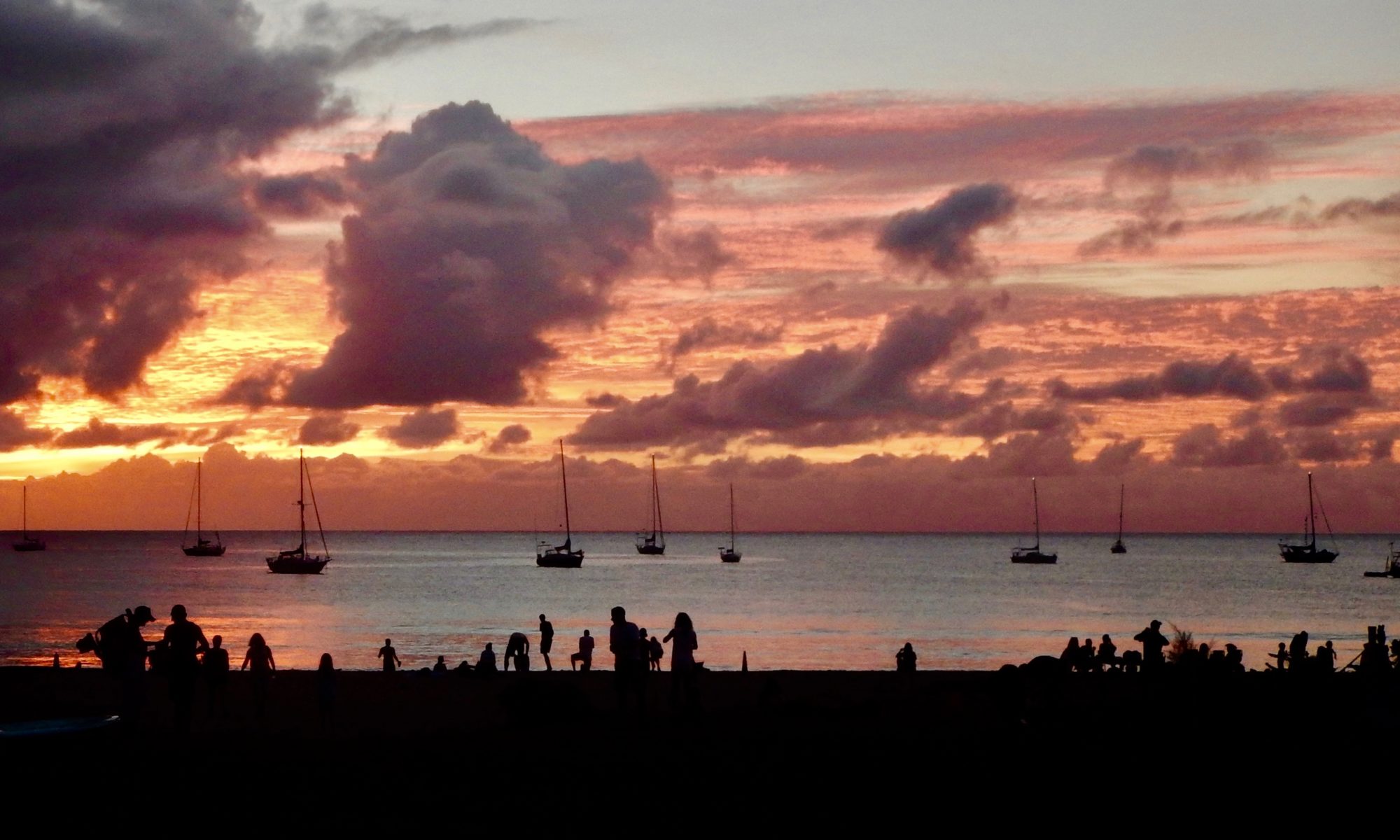Misadventures with the Singlehanded Sailing Society
There’s a secret society out there, hard to find and difficult to infiltrate. Its members refer to it as “a bug light for weirdos on boats.” While I was anchored in sleepy Hanalei Bay this summer, on the far northwestern edge of Kauai, this underground operation began arriving in fast boats — the 2018 Singlehanded Transpacific Yacht Race!
This epic race goes from San Francisco straight to Hanalei Bay — the same route that I’d just taken. I’d heard about this race for a lot of years. It’s been happening every “even year” since 1978. I’d thought about joining.
The Singlehanded Sailing Society sponsors a number of quite interesting races for solo sailors, like the Singlehanded Farallones Race which has been going strong every year since 1977. The Singlehanded Transpac is their capstone event and attracts a couple dozen sailors racing their own boats, some of them ultralight boats like the Olson 30 and some cruising boats like my Pamela, a Crealock 37. There are no sponsorships, no paid professionals, no cash prizes, and the SSS is famously “not a yacht club.”
I decided to call them up and figure some way to get involved with these “buglighters” when I sailed into Hanalei at the end of May. The SSS website led me to Carliane Johnson, webmaster/secretary for the club and one of the solo racers in the 2018 event. I explained that I was onboard Pamela, just in from San Francisco, and would like to help, and Carliane answered back, “Great! See you under the Tree!” a reference to their longstanding ritual of meeting at 5:00 p.m. each day for Tree Time.
Soon the Race Committee arrived and began to post updates such as “it’s early morning in the Little Yellow House and we’ve just fed the chickens”, like a day in the life of Bilbo Baggins. But where was their base of operations. Where exactly was this yellow house and this famous Tree?
I walked the length of Weke Road looking for a yellow house, from the sinkhole by the Hanalei River that swallowed up a half-dozen multimillion dollar homes in the April flood disaster, to the end of town a mile down the beach, and still could not locate this yellow house.
Then one morning while making my coffee, I saw a new boat on the bay, Double Espresso, looking like it had just had a wild ride across the Pacific. I checked the SSS blog and saw a short video of the winner, Philippe Jamotte, being ferried to shore, jumping into the surf up to his neck and treading through the surf to the beach. Then off he went with the Race Committee presumably to the invisible yellow house.
While I was snoring in my bunk the winner arrived and I missed it. Would I completely miss the 2018 Transpac while anchored right next to the finish line?
I launched my dinghy straightaway and headed to the beach. I had to find these guys. I found them across the road from the beach pavilion, hidden behind a lava-rock wall, a yellow house with a sign that read “Singlehanded Transpac 2018.”
I strode right into the kitchen with the biggest grin I could muster and shouted, “There you are! I’ve been looking everywhere for you guys! A subdued group of four or five complete strangers stopped their conversation and stared at me for a half a minute in complete silence.
I was wearing my Hanalei outfit—swim trunks, no shirt, no shoes, shaggy hair and whiskers under a big straw hat. Rather like the homeless guys in the beach pavilion across the road. Their expressions said who are you, exactly? Was I trying to sell them hard drugs or murder them outright? I mumbled “see you later then?” and dinghied back out to Pamela to sulk.
The SSS is not a secret club. Strangers are welcome. But you should probably put on a shirt for the first meeting.
Meanwhile the second and third finishers, David Clark on Passages and Greg Ashby on Nightmare, arrived that night, and once again I missed their arrivals. My aspirations with the Singlehanded Sailing Society were going up in flames pretty fast.
My luck began to change when I discovered that the Race Committee was monitoring VHF channel 69. I switched on my radio and soon there was a hail. A boat was dragging its anchor and Rob McFarlane on Tiger Beetle was trying to rescue Crinan II as it drifted out to the reef across the bay. I jumped into Pamelito my dinghy and raced over to lend a hand.
“Can you point out a good spot to anchor?” Rob called to me. “Certainly!” I escorted the little racer to a spot upwind of Pamela where I knew the holding was good.
I’d be the first to know if Crinan II were to drag her anchor again. Soon more racers began to arrive and I was making countless trips to and from shore to help the Transpac finishers find their land legs. My status rose from beach hobo to fleet savior!
Late that evening one of the boats arrived in a squall with rain coming down in sheets. Sea Squirrel, the Race Committee chase boat, drove out into the storm to help guide the squall-blinded skipper. I watched her navigation lights out beyond the surf break, occasionally hidden by the swells. Then she hailed the Race Committee to report that her engine would not start. Sea Squirrel was drifting quickly out to sea!
“Pamelito on the way!” I spoke into my radio, then set out into the night to lend a hand.
On calm days I’d taken Pamelito out to the surf break to watch the local board riders, but never beyond the furthest break, and never at night. Yet here I was, planing my dinghy over five-foot swells and hoping not to lose sight of the Sea Squirrel.
After several minutes I arrived at the stalled boat. Synthia Petroka, her skipper, threw me a line and I hauled it over my shoulder and turned my dinghy toward the lights on shore. When the line tightened it nearly threw me from the dinghy. Pamelito struggled desperately to tow in the heavier boat but could only whip- saw from side to side. Now I too was in danger of being swept out to sea!
“Try putting your dinghy on the side here, just abaft the beam,” Synthia suggested while Jackie Philpott helped me hold Pamelito to the aft quarter of Sea Squirrel. It worked! Pamelito with her little outboard began pushing the committee boat down the swells and back into the bay, slowly, slowly.
As I towed the disabled boat into the bay I pondered the seriousness, and potential hopelessness, of the situation. My teeth were chattering and I wished I’d put on a shirt before starting off on this rescue attempt. I was soaked, shaken, and wild-eyed, while Synthia and Jackie were as cool as a couple of pickles. They tied Sea Squirrel to her mooring and Synthia diagnosed and solved the boat’s ignition problem. Then I ferried the Squirrel girls to the beach and arrived back at Pamela around midnight, exhausted and spent as my outboard ran out of gas and sputtered out.
The following day was the Really Big Day as six boats arrived one after another. Each time, we escorted the boat into the bay, assisted with anchoring, and stood by to ferry the skipper to shore.
And then came Riff Rider. At the stroke of midnight skipper Charlie Casey found himself between the reefs protecting the bay and unable to see the boats in the anchorage nor the lights on shore, his engine disabled, leaking coolant, and a halyard knotted in a turk’s head around the spreader.
Rob in Little Beetle, the Squirrel girls Synthia and Jackie, and I in Pamelito pointed our boats into the swells and motored out to help Charlie feel his way through the blackened bay. There was a new moon—meaning, no moon at all—and thick clouds covered the night sky. The squalls dumped rain on our heads while we circled Riff Rider with our red headlamps serving as navigation lights. Charlie thought a swarm of lightening bugs were attacking from all directions. He had no idea who or what we were.
Riff Rider’s boom was swinging in the swells, her mainsail dumping wind with each gyration, and making near-zero progress against the offshore wind. Our dinghies scooted back and forth around her, pointing the way and trying to avoid each other. A half hour ticked by.
I was turning donuts around Riff Rider, trying to stay awake, and not paying much attention to the blackness over my shoulder. Suddenly there was Sea Squirrel on my quarter. I’d crossed her bow unaware.
Now, if this had been an 18th century British warship maneuver I’d have launched two dozen 18-lb. cannon balls into Sea Squirrel’s bow and become the next Lord Nelson. But it wasn’t.
My headlamp winked on half-batteries to announce my victory at the Battle of Trafalgar. BAM! Lesson learned: never turn donuts around a racing yacht on a midnight-black reef-strewn lee shore with a headlamp you wouldn’t take to a Boy Scout Jamboree. What an adventure I was having with the Singlehanded Sailing Society.
At 03:00 we had Riff Rider safely anchored in the bay. Commodore Dave Herrigel hailed us on VHF 69, advising us all to get some sleep, for the next boat was due to arrive in five hours.
The next morning I was pronounced an honorary member of the Singlehanded Sailing Society, and the Squirrel girls presented me with a highly coveted navy blue rain jacket with the Race Committee logo emblazoned on the shoulder.
Now I was a buglighter! I was having a blast with my new friends.
I learned that Jackie had recently published her book Not a Yacht Club, which tells the story of the SSS in entertaining interviews with several of its longstanding members, many who have become famous in the world of ocean yacht racing. On my solo journey back to San Francisco I read it cover-to-cover, as well as George Sigler’s Experiment in Survival.
Will I ever do a Singlehanded Transpac? The belt buckle is pretty cool. I’ve sailed 10,000 miles solo on Pamela so I know the drill. But alas, the old girl is a cruising sailboat, not a racer. I’d have to leave my dinghy engine at home, empty her water tanks, get rid of all my spare diesel, unship the heavy spare anchors, and dump my 200 feet of 3/8-inch anchor chain. So as not to arrive a week after the awards ceremony I’d have to dismantle all the things I’d want for a summer voyage to Hanalei.
But wouldn’t that be a great way to guarantee I’d sail back here in two years? A voice in my head says, “You’re not getting any younger although you’re acting like a post-adolescent Peter Pan. Better do it.”

